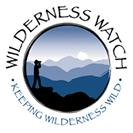Wilderness Watch
Wilderness Watch is the only national organization that is solely dedicated to the protection and proper stewardship of the more than 107 million acres that make up the National Wilderness Preservation System (NWPS). Our NWPS, the largest system of wildlands in the world, is over one-fifth of all federal land and bigger than the area of California.
Wilderness Watch is a non-profit organization that grew out of the concern that while much emphasis is being placed on adding new areas to the NWPS, the conditions of existing Wilderness are largely being ignored. We believe that the stewardship of these remarkable wild places must be assured through independent citizen oversight, education, and the continual monitoring of federal management activities.
YOUR DONATION COUNTS
Government works best when citizens are actively involved. Wilderness Watch reads the fine print, enters the public dialog, and scrutinizes wilderness management in the bright light of the great environmental laws of our time, the Wilderness Act, the Wild and Scenic Rivers Act, the Endangered Species Act, and others. When government agencies don't measure up to the promise of these laws, we bring citizens' voices to the table and sometimes appeal their decisions up the chain of command. In rare instances, we ask judges for an objective ruling. Our record of success in federal court is nearly unblemished.
The Wilderness Act instructs agency managers to preserve the high quality of the air and water, to leave the land and wildlife undisturbed, and to allow for outstanding opportunities to enjoy solitude and primitive, unconfined recreation. Wilderness Watch works to ensure that the stewardship of these special places lives up to the high standards of the law.
For analysis of the Wilderness Act and for more information about Wilderness Watch, please visit www.wildernesswatch.orgOn the Watch
Focus on Pasayten Wilderness, WA
The 530,000-acre Pasayten Wilderness, which lies along our border with Canada and adjacent to North Cascades National Park, is the wildest country in the North Cascades. It is the priority area for restoring grizzly bears to the Pacific Northwest and, in fact, grizzlies have been known to roam into the area from Canada. The Pasayten is also home to the largest population of lynx in the Lower 48. Deer, moose, mountain goats, bighorn sheep, and gray wolves comprise some of the area wildlife. The forest here is diverse and changes from western Washington fir, cedar, and western hemlock to the fir, pine, and larch typical of eastern Washington. Pasayten topography boasts 150 peaks over 7,500 feet in elevation, rugged ridges, and deep drainages. There are over 160 bodies of water and at least as many waterways.
The Pasayten is poorly managed and is suffering significant damage from packstock associated with commercial outfitters. It's a sign of the times that, while the Forest Service has admitted the impacts of packstock use here violate its own management standards, it refuses to take action to prevent harm to the Wilderness.
This summer, the Forest Service will be releasing a draft environmental impact statement (EIS) and a long-term plan for managing commercial packstock in the area. Wilderness Watch will review the plan and EIS. Working with local activists and conscientious outfitters in the Pasayten, we will pressure the agency to adopt Wilderness protection measures. The EIS presents our best opportunity in two decades to improve protections for the Pasayten Wilderness.
You can help Wilderness Watch in this case and many others that degrade wilderness character by joining us. Please visit www.wildernesswatch.org today.
